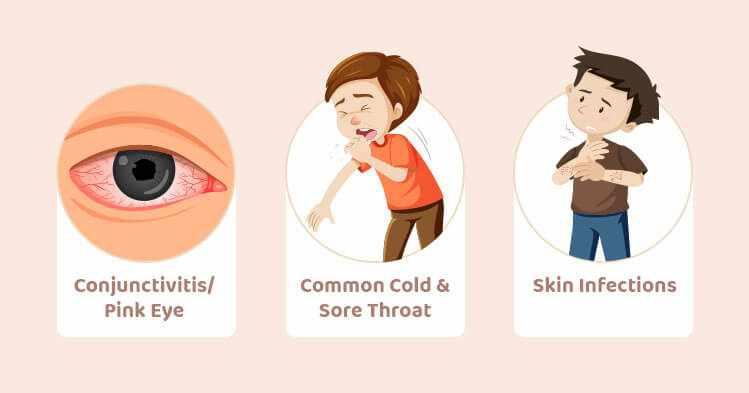7 Common Childhood Illnesses and Knowing When to Seek Medical Attention

Younger children are the most vulnerable to infections, keeping their parents on their toes. The reason behind such encounters is a weak immune system. Therefore, as parents, you need to understand the common childhood illnesses, symptoms, and prevention. You should even know the right time to contact a pediatrician.
Today we will discuss the most common childhood illnesses with their symptoms to help you be well-prepared for a diverse upcoming.

1. Conjunctivitis/Pink Eye
One of the most contagious and common childhood illnesses, conjunctivitis onset, is major during the rainy season when humidity is very high. It is an eye-based infection due to bacteria, viruses, or allergies leading to red and puffy eyes.
Children tend to get irritated since their eyes swell up and itch. Also, there is constant white discharge around the eye which is sticky and makes it difficult to see, making it an uncomfortable situation for the child.
Symptoms and signs: Initially, your child might feel itching in the eyes and discomfort, leading to redness and swelling.
Prevention: Hand hygiene is the only way to prevent infection since the illness is contagious. Regular hand washing and avoiding touching eyes often, especially after visiting a public place, is crucial. It is suggested to evade contact with infected individuals and not share personal use items.
When to consult: If your kid suffers from conjunctivitis, you should consult an ophthalmologist. He would suggest over-the-counter medicines to control the further worsening of the condition. Cold compress also helps a lot in easing up the swelling. Usually, it takes 3-5 days for the situation to get better. Some children take up to a week to be fine.
2. Common Cold & Sore Throat
This one is the topmost in the list of common childhood illnesses. Children tend to catch colds and sore throats with fluctuating temperatures and humidity. An infection due to a virus in the upper respiratory tract leads to cold, while a sore throat results in pain in the throat triggered by the bacteria Streptococcus.
Symptoms and signs: This contagious infection include several common symptoms that are easy to identify. Even though it isn’t a serious health condition, it should not be ignored, as your child may suffer a lot if the right medications aren’t administered. Some symptoms are:
- Pain in throat
- Runny nose
- Fever
- Body ache
- Vomiting
- Sneezing
- Shivering
Prevention: Flu vaccination is a great way to minimize incidents of cold and flu throughout the year. This vaccine is given once every year, preferably during months when humidity levels are high. Teach your child the importance of maintaining personal hygiene. Also, make them cover their mouth and nose when sneezing so that people around them aren’t exposed to the virus and bacteria.
When to consult: Regular cold and sore throat encounters further weaken immunity. Therefore, it is important to consult a doctor in time. Most children experience high fever during this very strenuous situation. The expert may suggest antibiotics, pain relievers, and fever medications to control the infection.
Allow your child to take proper rest and feed healthy, light meals. Also, give fluids to keep your child hydrated at all times. If there is no improvement in a few days, your pediatrician may suggest tests for an exact diagnosis.
3. Skin Infections
Your child’s skin is very sensitive and prone to skin infections, especially during monsoon and humid conditions. Skin infection is one of the most common childhood illnesses and can be caused due to different reasons. Some common infection types are:
- Fungal infection: There are several fungal infections in kids, like athlete’s foot, jock itch, ringworm rash, tinea skin infection, etc. Each infection has a different root cause; thus, consulting a dermatologist is wise.
- Bacterial infection: Bacteria are always present on human skin, but finding them with the naked eye is impossible. If the bacteria grows exponentially, it has a severe impact on the skin as paronychia (nails), cellulitis (skin surface), and impetigo (scaling of skin and blisters).
- Viral infection: Herpes, hand, foot mouth disease are some examples of infections caused in children.
Common symptoms: Most skin infections result in skin eruptions, rashes, itchiness, swelling of the skin, etc.
Prevention: The only way to prevent a skin infection is to identify its triggers. Maintaining a proper cleanliness routine is also important.
When to consult: You should watch your child and refer to a dermatologist when you find something wrong. Fever is also a common symptom as the child’s body tries to fight the infection. A doctor will suggest oral or topical medicine according to the cause of the infection. It is necessary to consume medicines on time for quick recovery.

4. Ear Pain
When talking about common childhood illnesses, ear pain is another problem that most kids suffer from. Ear pain is immensely painful, and your kid may get very irritated. Every child is different; some are prone to ear infections often, and others may suffer only due to underlying health reasons; for example, sometimes severe cold also leads to painful ears.
Common symptoms: Pain is the first sign of ear infection; however, the onset of fever, hearing issues, foul-smelling discharge from ears, and pain when eating are the other symptoms you should watch out for as parents.
As parents, you should also know the possible causes of an infection. Some of these are:
- Sinus infection
- Infection while swimming
- Allergies, bacterial or viral infections affecting the middle ear, or otitis media.
When to consult: Ear pain is a serious issue that cannot be managed with home remedies. You should consult a pediatrician or ENT as soon as your child complains. The doctor may suggest antibiotics and ear drops based on which part of the ear is infected and how severe it is.
5. Urinary Tract Infection
UTI is one of the few common childhood illnesses in girls caused by bacteria, as their urethra is shorter than boys.
Common symptoms: Frequent urination with a burning sensation and groin pain are the signs parents should be aware of. Sometimes, the child may also suffer from fever and back pain.
Prevention: Teach your child the right way of cleaning the anal area, as mostly, wrong cleaning practices lead to bacterial growth. Also, regular washing and drinking fluids in good quantities can help prevent the situation.
When to consult: UTIs need to be treated timely with antibiotics. Your doctor may prefer a urine test to know the severity of the infection to prescribe medications.
6. Cough
Almost all parents are aware of coughs as common childhood illnesses and symptoms, but it is difficult to avoid encounters with this illness in younger children. There are two types of cough: dry, where no mucus is produced, and wet, where mucus is formed. The treatment, too, differs conferring on the symptoms and type of cough the child suffers from.
Symptoms and signs: Nasal congestion, throat irritation, runny nose, and fever are some symptoms associated with cough. A cough can cause airway infections and congestion if not treated in time.
Prevention:
- Avoid cold foods and beverages if your child is prone to cough.
- Tell your child to avoid contact with infected individuals and use humidifiers if possible.
- Give honey to your kid regularly as it soothes the throat and cough.
When to consult: A rigid cough can lead to sleepless nights. Therefore, you should visit a doctor for proper medications. Never give medicines yourself since this may lead to serious consequences. A pediatrician may suggest nebulizing or steam to stop further mucus development.
7. Chickenpox
Chickenpox is a viral infection where your child may have cold-like symptoms and develop small red spots on the body. If not taken care of properly, the rashes become yellow blisters. These blisters are painful and itchy that irritate the child.
Symptoms: High fever and common cold are initial signs, and later on, rashes develop. Thus, parents need to be vigilant about such common childhood illnesses.
Prevention: The best way to prevent chickenpox is to vaccinate your child. This reduces the chances of infection in the future. However, if there are infected people around, keep your child away and always maintain personal hygiene.
When to consult: Consulting the doctor on time is very important since you may consider it the common cold. The doctor will suggest medicated baths and lotions to soothe the itchy rashes. Ensure that your child rests properly and takes prescribed medicines on time.
Now that we have discussed the list of common childhood illnesses, as parents, you should teach best hygiene practices to your child as this helps avert difficult situations. It is advisable to take a specialist’s guidance, as children are delicate and cannot care for themselves.
Conclusion
So, as parents, it is crucial to keep a close watch on your child’s actions and behavior so that you know when an infection has started. This helps avoid the worsening of the situation with timely treatment. The most common childhood illnesses with their symptoms help you to be prepared for the future.








